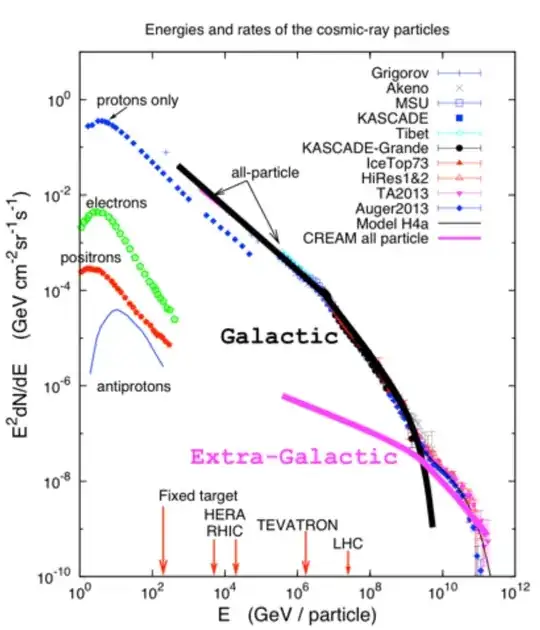Robert Hummel's claims are quite inaccurate, in a number of ways.
The gamma ray flux on Earth
Earth's atmosphere is effectively opaque to gamma rays and cosmic rays, the latter of which are high-energy protons or the ionized nuclei of other elements. Gamma rays - in particular high energy gamma rays - are emitted by objects like active galaxies, pulsar wind nebulae, and gamma ray burst progenitors. They create a spectrum that can be roughly described as a two-part broken power law that decreases with increasing energy.
The vast majority of gamma rays that reach Earth collide with particles in Earth's atmosphere at altitudes of 20-30 km (see Ozlem Celik's PhD thesis), 3-5 times as high as the altitudes Hummer is referring to. They create electron-positron pairs, which then lose energy through a mechanism called bremsstrahlung, in turn emitting more photons, which create more electron-positron pairs. This is what we call an air shower, and even though (optical) radiation from these particles will eventually reach Earth's surface, large amounts of it will be dissipated (Abeysekara et al. 2017). Even the air shower from a 1 TeV gamma ray will lose ~93% of its energy by the time it hits the ground, and at 20,000 feet, the remaining energy should still be significantly small.
To quantify this a bit more, we can say that the atmosphere has a thickness of 1000 grams per square centimeter, or about 28 radiation lengths (Funk 2015; arXiv version). The radiation length is the distance over which the gamma ray flux decreases by a factor of 1/e; it is roughly 37.7 grams per square centimeter (see Celik). (Side note: Funk says that Earth's atmosphere is equivalent to about 1 meter of lead, which means that Hummer's claim of 125 meters of concrete shielding is a little unlikely, as the gamma ray flux through that much material would seem to be quite close to zero.)
We can convert an altitude to radiation lengths by linearly integrating the density of air to a given altitude. At 13,000 feet, the atmosphere has a depth of 16.7 radiation lengths; at 36,000 feet, this is 6.1 radiation lengths. At 20,000 feet, somewhere in the middle (~12) seems reasonable, meaning that a camera at 20,000 feet will receive e28-12 = e16 = 8.8 million times as much radiation (roughly) as a camera on the ground.
How much is needed to damage a camera?
Not surprisingly, scientists care about how much damage instruments suffer from radiation, including gamma rays and cosmic rays. It turns out that the performance of a high-resolution (AVT Marlin F-145C2) camera degrades at exposures of about 100 milliSieverts per hour of low-energy (100 keV - 1.5 MeV) gamma rays (Marbs & Boochs 2006).
Now, Earth does receive higher energy gamma rays - for instance, we see particularly interesting high-energy (TeV and, rarely, PeV) emission from various galactic and extragalactic sources. However, both the cosmic ray and gamma ray spectra follow a sharply decreasing double broken power law with increasing energy. Here, for instance, is the cosmic ray spectrum incident on Earth's atmosphere, from 1 GeV up (image credit: IceCube):

At 100 MeV, this may mean rates as high as 100 particles per square meter per second. However, after the attenuation of the Earth's atmosphere, this flux drops substantially, as we showed before. Go up by an order of magnitude in energy and your particle flux drops off by a factor of 100 or so, meaning the contribution of high-energy gamma rays is not substantial. I would argue that the analysis of the authors is applicable to the high-energy portion of the spectrum, too, simply because a camera at 20,000 feet will not be exposed to many high-energy particles on a flight of a few hours.
At even 10,000 feet, a human is exposed to about 5 microSieverts per hour; a camera would presumably be exposed to even less. Even 5 microSieverts per hour, however, is substantially smaller than the threshold given by Marbs & Boochs. Moreover, if I wanted to be nitpicky, this figure includes cosmic rays, not just gamma rays; the gamma ray contribution would be much smaller.
I think we can definitively say that no, gamma rays on an airplane will not damage a digital camera. In outer space, without the protection of Earth's atmosphere? Yes, both cameras and film can be quite easily damaged by cosmic rays and gamma rays.
For context, I'm currently doing work in ground-based gamma-ray astronomy as part of the VERITAS group.
